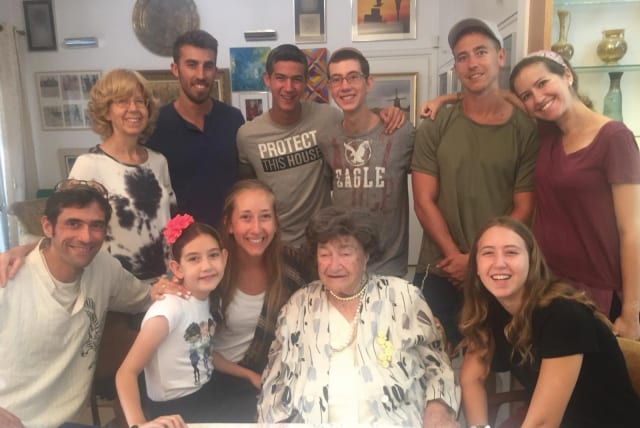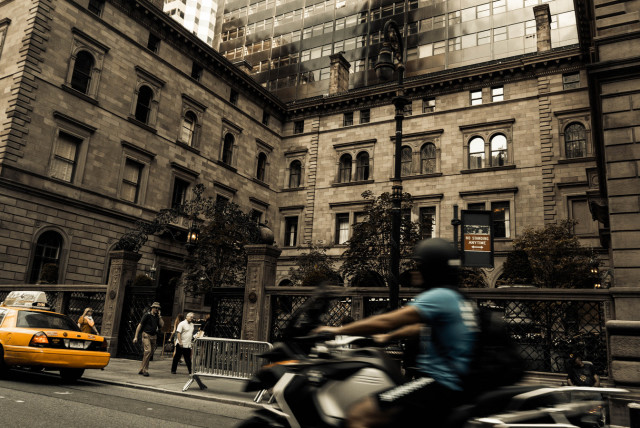Meet the grandmother whose sukkah and kindness were for all - opinion

The second-to-last sukkah in our Oma’s life was suffused with the timeless tradition and vitality that define the Jewish family.
This week, we commemorate the passing of our grandmother, Oma Els Bendheim, an awardee of the Yakir Yerushalayim Prize. Her legacy is relevant for this defining moment in our history.
The last three months have been a somber yet determined period in our nation and our family. The largest single-day massacre of Jews since the Holocaust and the ensuing war has exacted a tremendous price from the Jewish people and from Oma Els’s family as well. Two of our oma’s great-grandchildren, Joey Guedalia and Ben Zussman – our cousins, members of this extraordinary generation of young people with moral clarity – have fallen defending the people and the Land of Israel.
Oma Els put her family, her tribe, our tribe, first in word and deed. She insisted on opening her tent and sukkah for all Jews and powerfully taught lessons of Jewish pride, moderation, and inclusiveness that are so needed today.
Oma always built a big sukkah and filled it with people, some of whom she knew previously and others who just wanted or needed a place to eat. She often took her books and pamphlets from the packed shelves or out of the overflowing closet to show the newbies, always looking to spread the word and challenge people. She taught us to be attentive and able to talk to all the different people from different levels of society that came into her sukkah and home. You would not be mistaken for seeing these traits in Ben Zussman’s will or in the portrait of Joey Guedalia.
When Yom Kippur ended this year, I experienced an unusually somber moment. I was profoundly sad because, for the first time in many years, I didn’t get a call from my grandmother, who passed away in January at age 99, asking where I was and when I could build her sukkah. For reasons I cannot explain, the honor and responsibility to build Oma’s beautiful and expansive sukkah in Jerusalem were bestowed upon me and my sons. Her reminders to be ready to build the sukkah started already after Passover and sometimes even earlier.
When nobody was building a sukkah on the West Side of Manhattan in the 1950s-1990s, my grandparents erected one. The long, green wooden sukkah on the balcony of 101 Central Park West was a magnet. Dignitaries and ordinary families would come for one of the two seatings and the opportunity to slither into and crawl under the table of the extremely narrow sukkah in order to fulfill the mitzvah of the holiday.
When I was a child, I met former Israeli Supreme Court justice Elyakim Rubinstein in that sukkah. I also met our distant cousin alongside former Israeli consul-general in New York Naftali Lavie (brother of Chief Rabbi Yisrael Meir Lau). They sat next to whoever was staying at my grandparents’ – those who were getting medical treatment at one of New York’s hospitals or random people our oma had picked up.
What was Oma like?
MY GRANDMOTHER was indeed extraordinary. In his portrait of our Oma Els in Tablet Magazine, Theodor Dunkelgrün called her an illui, a genius. I used to joke that before there was Wikipedia, there was Oma Els. She had a mental map of the Jewish world and all of its connectivity. She knew how everyone was hyperlinked, what and who they uniquely knew, and what they could do. At her shiva, we heard about the young newlywed who was arrested in Paris; his new bride called our Oma, who immediately set up a command center, calling the Jews she knew in Paris to take care of the young woman and help release her incarcerated new husband. We heard about the family from Manhattan Day School that was sitting shiva in the scorching summer heat and humidity of the Lower East Side of Manhattan, to whom Oma sent air conditioners in the 1970s. Or, as my Aunt Judy z”l would joke, Oma reminded all those who met her later in life of everyone in their past whom they spent years trying to forget.
Dunkelgrun’s portrait of our Oma as a scholar and ilui, however, elides her salient qualities, abilities, and message. The proper portrait of our Oma is best illustrated by the beautiful, open sukkah and two small books that I believe were the seminal works of which our oma was most proud.
Oma worked with the renowned Rabbi Menachem Kasher on a booklet titled The Manhattan Eruv. The eruv (technical boundary that allows Jews to carry in public areas on Shabbat) that Manhattan has would not have been possible without the groundbreaking work our oma did in 1962. At the time, leading rabbinic scholar Rabbi Moshe Feinstein and most other rabbis opposed building an eruv in Manhattan. Our grandmother could not fathom a world in which mothers would be stuck at home; without an eruv, they could not carry or push strollers outside, and their children would not experience shul. She could not fathom Halacha (Jewish law) that would prohibit handicapped people or injured people from going to synagogue.
When my grandmother was young, people often commented, “There is Mrs. Bendheim. She’s pregnant again.” She had seven children on the West Side of Manhattan when big families were not common, not even in ultra-Orthodox circles. When our grandfather, Opa Charlie, passed away, our Oma decided that there would be an annual commemoration of his passing on hol hamoed (the interim days of) Passover, even though he passed away a couple of weeks after the holiday.
She correctly assumed that an annual, somber memorial service would not attract any children, grandchildren, great-grandchildren, or great-great-grandchildren, and that the event would naturally die out over time. Instead, she hosted a yom kef, a fun day. More than 25 years after our Opa’s passing, the day still attracts hundreds of their descendants and has kept the family close, despite its increasing size. Many of our children still say that it’s their favorite day of the year.
I believe it was the importance of family, not scholarship, that inspired her pursuit of her grandfather’s legacy, which is covered in the two books that Dunkelgrun references – Parnas L’doro and Parnas L’dorot. Our Oma sought to ensure that her grandfather Liepman Philip Prins’s unique scholarship and story would be passed down to all of her descendants. She insisted that we all have copies.
This brings me to the other small booklet my grandmother produced. In 1990, together with Rabbi Meir Hershkowitz, she published The Lesson of Amalek.
Teaching children the mitzvah of wiping out Amalek in the modern era is a tricky topic, to say the least. But the challenge of educating the next generation is exactly what motivated our oma to take on this fraught topic. Again, partnering with a rabbi and scholar, she distributed the pamphlet to schools and anyone she could. Tragically, since Simchat Torah this year, the need to understand the lesson of Amalek has become more real for all of us.
Our Oma was ahead of her time. Besides raising a large family, she earned a degree in chemistry from Barnard College. She challenged rabbis. She single-handedly launched an anti-smoking campaign in haredi yeshivas, insisting that in the words of the Torah, one must treasure human life. She used her knowledge and network to take responsibility. To paraphrase my esteemed rebbe, the late Rabbi Aharon Lichtenstein, Oma understood that opportunity is responsibility and that if it is possible, you are responsible. Oma had opportunity, and she made things possible. She simply and forcefully took responsibility and, by example, expected us to do the same.
SHE INSISTED that her sukkah be beautiful. In Manhattan, the schach (thatch covering) was made from pine. When she moved to Israel, she did not like the palm branches or brown dry mats that were used, thinking they were not inviting enough to attract guests, so she bought dozens of bushels of scented eucalyptus every year.
Two years ago, at the end of COVID, my boys and I had just finished stuffing the endless number of branches in the roof when Oma muttered, “Come take a picture for my mother.” I said, “Excuse me, I am not sure I heard you correctly.” Again, she said, “All of you, come take a picture with me for my mother.” I thought she must have been hallucinating, even though she was quite sharp until her last few months. I came down from the ladder and slowly walked over to her as she sat regally dressed at the entrance to the sukkah. I whispered in her ear, “Oma, your mother is no longer alive. Why do you want to take a picture for her?” She smiled and said, “I know my mother is dead, but I know she would be happy to see what a beautiful and big sukkah we are all building together.”
I then realized that we were building not just a sukkah for five generations but a temporary dwelling for eternity. This second-to-last sukkah in our Oma’s life was suffused with the timeless tradition and vitality that define the Jewish family and the preeminence of living and leading the generations that our matriarch so cherished and modeled for us.
Jerusalem Post Store
`; document.getElementById("linkPremium").innerHTML = cont; var divWithLink = document.getElementById("premium-link"); if (divWithLink !== null && divWithLink !== 'undefined') { divWithLink.style.border = "solid 1px #cb0f3e"; divWithLink.style.textAlign = "center"; divWithLink.style.marginBottom = "15px"; divWithLink.style.marginTop = "15px"; divWithLink.style.width = "100%"; divWithLink.style.backgroundColor = "#122952"; divWithLink.style.color = "#ffffff"; divWithLink.style.lineHeight = "1.5"; } } (function (v, i) { });

